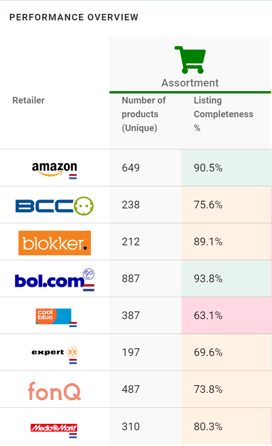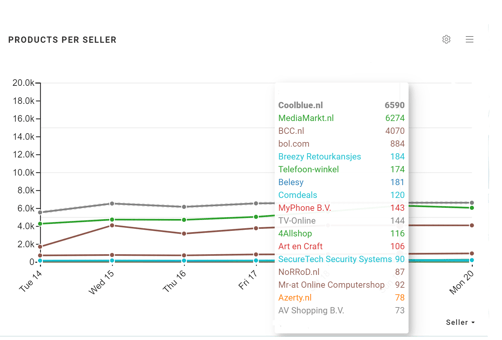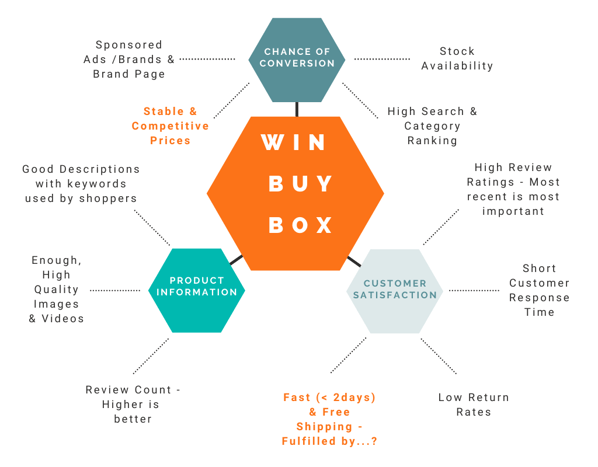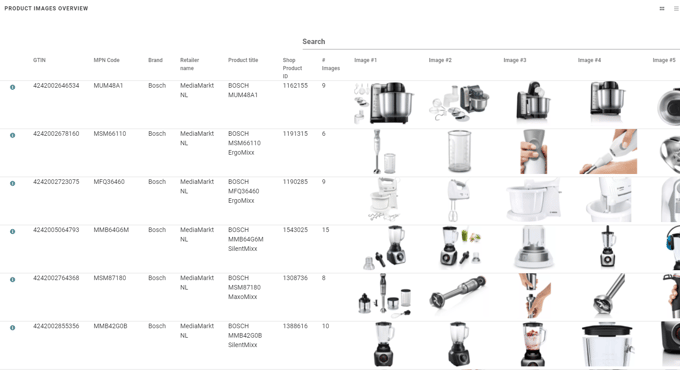Most brand manufacturers don't realize that the digital shelf impacts their sales, profitability, and brand image. Understanding that impact and how to act upon it can make or break a brand's potential to win in eCommerce. Digital shelf data and insights can benefit multiple departments within a brand manufacturer company — From digital marketers and sales managers to product development, supply chain, and online merchandising specialists.
Learn in this blog how they can all leverage digital shelf monitoring for your brand.
TIP: If you do not want to read the full blog, watch a 5-minute video in which digital shelf consultant Roel Pardoel explains how you can benefit from digital shelf monitoring within your role.
A cross-functional path
The digital shelf involves your entire company, from eCommerce marketers and sales managers to product development, supply chain, and merchandising specialists.
You might have the necessary employees or plan to add them to your teams. If you do not have the resources in-house, you might want to look into external support to map out your strategy, create an action plan for achieving your goals on the digital shelf, and translate your eCommerce data into results.
Digital shelf roles, challenges, and solutions
Role
|
Challenges
|
Solutions
|
| eCommerce & Brand Managers |
Monitoring online assortments, Products get lost on the shelves, Unauthorized sellers |
Online assortment monitoring |
| Sales & Account Managers |
Price wars, benchmark competitors, keep margins profitable, win the buy box |
Price tracking and pricing alerts |
| Digital Content Specialist |
Content compliance, Retailer content guidelines |
Content quality scorecards, product image overviews |
| Marketing Specialist |
Search placement dynamics, benchmark competitors |
Keyword and share of search tracking |
| Consumer Relations |
Gain ratings & reviews, analyze and utilize customer feedback |
Review monitoring |
| Supply Chain |
Maintain high in-stock rates |
Stock availability monitoring and alerts |
Let's look deeper into each role's challenges, starting with eCommerce- and Brand Managers.
eCommerce & Brand Managers
Challenges:
Products get lost on the shelves
Ideally, online resellers list your products on their sites as they agreed upon with the sales teams– New product introductions are listed respecting the launch date, and obsolete products and content be removed on time.
In reality, information and content assets are often not taken over one-on-one and end up incorrect or get lost on the digital shelf. Taking control of, and managing your assortments online, can be challenging when products are available across multiple retailers and marketplaces.
Unauthorized sellers
Another pain point is the third-party sellers who buy your products and resell them on marketplaces such as Amazon and bol.com without your permission.
Solution:
Assortment monitoring
By monitoring retailers and third-party sellers, you can ensure the accurate brand assortment is present on all eCommerce channels without checking product pages one by one.

With assortment monitoring, you can visualize the exact SKUs listed across retailers by using performance overviews. Also, track which products are missing and who is selling your products (without permission) on marketplaces.

Sales & Account Managers
Challenges:
Benchmark competitors
Competitor analysis is often part of the sales managers' job. When operating among numerous online competitors, it can be labor-intensive to determine which market segments your competitors are targeting and what pricing strategy they are using.
Keep margins profitable
Account managers want to cover costs, stay competitive, and ultimately make a profit. When discussing margins with resellers many data points need to be analyzed to be prepared for sharp negotiations.
Price wars
Account managers desire to maintain strong relationships with resellers. But what if unauthorized resellers enter the market, and cause a price war? A price war puts profit margins and your relationship with your partners at risk, and your brand and products can lose value in the customer's eyes.
Win the buy box on marketplaces
Price wars on marketplaces can lead to losing buy box placement and eligibility. But even without a price war, it's a challenge to win and keep that coveted buy button. Most marketplaces algorithms look for 'the best offer'.

Factors that affect chances of winning the buy box.
As you can see in the diagram above, there isn’t one magic element but a whole bunch of factors that go into deciding who has 'the best offer' and wins. Yet, the price is for sure an important one on each marketplace.
Solution:
Price tracking
To back you up in meetings, analyze daily online selling prices of at least the previous three months. The product price evaluation of the past three months is not only beneficial to achieve the targeted margins but also shows what a shopper is willing to pay and the perceived value.
Use price tracking tools to:
- Set up alerts that warn you when prices drop. By showing you who initiated a sudden price drop, you can prevent others from lowering their prices and prevent a chain reaction.
- Get an overview of the number of retailers in a given territory selling your brands and their prices. By not letting too many retailers on a (saturated) market, you can avoid fierce price competition between them.
- Tracking competitor selling prices can help identify which margins are needed for which products to remain profitable, stay competitive, and hit your financial objectives.
- Detect sellers who offer the lowest pricing options on a marketplace and take over the buy box from you (as a brand owner or vendor).
- Get price trends and insights into your market to help you understand and anticipate market developments.
-png.png?width=520&name=Kopie%20van%20Dashboard%20mockups%20(5)-png.png)
Digital Content Specialist
Challenges:
Content compliance
When consumers can't see, touch, or try products in a physical store, the value of digital content elements such as images, videos, and descriptions increases. Created product content is often not taken over one on one. This makes it a challenge for digital content specialists to ensure the content of your products is published complete, correct, and in line with corporate- and retailer guidelines, on all eCommerce channels.
Retailer guidelines
Product detail page elements and requirements demand customization for each retailer. A growing number of retailers have their content standards and guidelines in place for you to follow. Checking brand content compliance becomes next-level because of the customization across resellers.
Solution:
Content Quality Scorecards
Content quality scorecards can measure content compliance on all sales channels. First, customize the content criteria and weights so that it matches your and your retailers' requirements. Compare content guidelines against published content on retailer sites with the Digital Content Completeness (DCC) score. Receive automated reports on products with incorrect or missing keywords, product images, videos, or other attributes and bring content to a perfect level.
Product image overviews
Product image overviews let you discover all images listed by retailers at a glance and make it possible to filter out inconsistencies effortlessly.

Marketing Specialist
Challenges:
Retail search placement dynamics
When shoppers use keyword searches or category browsing on webshops and marketplaces, they will often buy a product that ranks high in the search results– No one can buy your products if they can’t find them. Search placements constantly change, making it difficult to control and keep up in the top retail search results.
Benchmark competition
Finding out which other brands' products you are competing with for the top positions in (category) search results on multiple channels is certainly not an easy task.
Solution:
Share of search monitoring & Content quality scorecards
Getting a position at the top of retail search engine results is a game consisting of many factors such as sales velocity, keyword-rich product pages, pricing, and reviews. To optimize your brands' placements in retail search you continuously analyze current rankings and who you are competing with.
 Retail keyword tracking lets you monitor your share of search and benchmark competitor brand search rankings. Adjust your KPIs to the outcome of your analysis and aim to improve over and over.
Retail keyword tracking lets you monitor your share of search and benchmark competitor brand search rankings. Adjust your KPIs to the outcome of your analysis and aim to improve over and over.
Consumer Relations
Challenges:
Gain ratings & reviews
Since the start of the corona pandemic, consumers were less able to interact with products, and reviews became more crucial. eCommerce boosted, and with it, survey fatigue– Just 5% to 10% of consumers write reviews because most online shoppers get overwhelmed by the number of requests for feedback or don't want to put time and effort into it.
Analyze and utilize customer feedback
Consumer relations teams need to forward valuable customer feedback about your products online to product managers and research & development teams. They have the challenging task of translating feedback into recommendations to meet customer needs and maximize sales. Gathering, and analyzing reviews across multiple retailers is a challenge.
Solution:
Review Monitoring
Define the number of reviews and star ratings your products currently have and benchmark against competitor products. Review monitoring software such as SiteLucent can help you with this job, as well as zooming in on underperforming products - Reviews with low numbers of reviews or those with 1- or 2-star ratings.
The first step to maximizing review collection is asking. Reach out to buyers and convince them to leave a review. The most effective way is sending review request emails that are on brand, simple, and to the point. To define the right questions, monitoring and analyzing reviews beforehand is crucial. This way, you can ask questions that you know will address key known customer issues.
Supply chain
Challenge:
Maintain high in-stock rates
For supply chain managers, it's a challenge to ensure that listed products are in stock, not to miss out on sales opportunities. Timely fixing out-of-stocks across multiple retailers can be difficult. Especially when promotions are involved is forecasting a hurdle. -png.png?width=679&name=Kopie%20van%20Dashboard%20mockups%20(4)-png.png)
Solution:
Stock availability monitoring
From Out-Of-Stock (OOS) alerts to availability rates per brand and days out of stock per retailer. SiteLucent tools can help you analyze and optimize at every level of product availability. OOS notifications and automated availability reports help your products be visible, win the buy-box and increase customer loyalty.
TIP: Download our free Guide to Digital Shelf Optimization with advice to optimize search rankings, buy box shares, and conversion rates.
